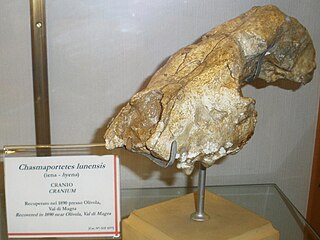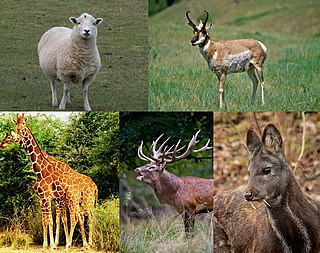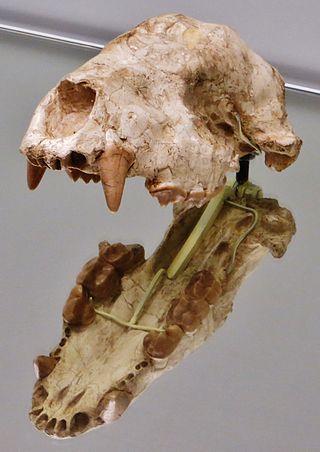
Viverridae is a family of small to medium-sized, feliform mammals. The viverrids comprise 33 species placed in 14 genera. This family was named and first described by John Edward Gray in 1821. Viverrids occur all over Africa, southern Europe, and South and Southeast Asia, across the Wallace Line. Their occurrence in Sulawesi and in some of the adjoining islands shows them to be ancient inhabitants of the Old World tropics.

The Bovidae comprise the biological family of cloven-hoofed, ruminant mammals that includes cattle, bison, buffalo, antelopes, and caprines. A member of this family is called a bovid. With 143 extant species and 300 known extinct species, the family Bovidae consists of 11 major subfamilies and thirteen major tribes. The family evolved 20 million years ago, in the early Miocene.

Amphicyonidae is an extinct family of terrestrial carnivorans belonging to the suborder Caniformia. They first appeared in North America in the middle Eocene, spread to Europe by the late Eocene, and appear in Asia, and Africa by the early Miocene. They had largely disappeared worldwide by the late Miocene, with the latest recorded species at the end of the Miocene in Pakistan. They were among the first carnivorans to evolve large body size. Later in their history, they came into competition with hesperocyonine and borophagine canids. As dogs evolved similar body sizes and cranial and dental adaptations, the rise of these groups may have led to their extinction. Amphicyonids are often colloquially referred to as "bear-dogs".

The mountain gazelle, also called the True Gazelle or the Palestine Mountain Gazelle, is a species of gazelle widely but unevenly distributed.

The rhim gazelle or rhim from Arab Language غزال الريم in Arabic(Gazella leptoceros), also known as the slender-horned gazelle, African sand gazelle or Loder's gazelle, is a pale-coated gazelle with long slender horns and well adapted to desert life. It is considered an endangered species because fewer than 2500 are left in the wild. They are found in Algeria, Egypt, Tunisia and Libya, and possibly Chad, Mali, Niger, and Sudan.

Kenyapithecus wickeri is a fossil ape discovered by Louis Leakey in 1961 at a site called Fort Ternan in Kenya. The upper jaw and teeth were dated to 14 million years ago. One theory states that Kenyapithecus may be the common ancestor of all the great apes. More recent investigations suggest Kenyapithecus is more primitive than that and is only slightly more modern than Proconsul, which is considered to be an ape.

Chasmaporthetes, also known as hunting or running hyena, is an extinct genus of hyenas distributed in Eurasia, North America, and Africa during the Pliocene-Pleistocene epochs, living from 4.9 million to 780,000 years ago, existing for about 4.12 million years. The genus probably arose from Eurasian Miocene hyenas such as Thalassictis or Lycyaena, with C. borissiaki being the oldest known representative. The species C. ossifragus was the only hyena to cross the Bering land bridge into the Americas, and ranged over what is now Arizona and Mexico during Blancan and early Irvingtonian Land Mammal ages, between 5.0 and 1.5 million years ago.

Pecora is an infraorder of even-toed hoofed mammals with ruminant digestion. Most members of Pecora have cranial appendages projecting from their frontal bones; only two extant genera lack them, Hydropotes and Moschus. The name “Pecora” comes from the Latin word pecus, which means “horned livestock”. Although most pecorans have cranial appendages, only some of these are properly called “horns”, and many scientists agree that these appendages did not arise from a common ancestor, but instead evolved independently on at least two occasions. Likewise, while Pecora as a group is supported by both molecular and morphological studies, morphological support for interrelationships between pecoran families is disputed.

Stupendemys is an extinct genus of freshwater side-necked turtle, belonging to the family Podocnemididae. It is the largest freshwater turtle known to have existed, with a carapace over 2 meters long. Its fossils have been found in northern South America, in rocks dating from the Middle Miocene to the very start of the Pliocene, about 13 to 5 million years ago. Male specimens are known to have possessed bony horns growing from the front edges of the shell and the discovery of the fossil of a young adult shows that the carapace of these turtles flattens with age. A fossil skull described in 2021 indicates that Stupendemys was a generalist feeder.

Percrocuta is an extinct genus of hyena-like feliform carnivores. It lived in Europe, Asia, and Africa, during the Miocene epoch.
Kanuites is an extinct genus of paradoxurine viverrid carnivore. It lived in Africa, during the Miocene epoch.

Paradoxurinae is a subfamily of the feliform viverrids that was denominated and first described by John Edward Gray in 1864. Pocock subordinated the genera Paradoxurus, Paguma and Arctictis to this subfamily.

Kipsigicerus is an extinct genus of East African antelope from the Middle Miocene. Its closest living relative is the four-horned-antelope.

A gazelle is one of many antelope species in the genus Gazella. This article also deals with the seven species included in two further genera, Eudorcas and Nanger, which were formerly considered subgenera of Gazella. A third former subgenus, Procapra, includes three living species of Asian gazelles.

Indarctos is an extinct genus of bear, endemic to North America, Europe and Asia during the Miocene. It was present from ~11.1 to 5.3 Ma, existing for approximately 6.2 million years.
Megapedetes is a genus of fossil rodents related to the springhare and other species of the genus Pedetes, with which it forms the family Pedetidae. At least four species are known, which ranged through Africa, southwestern Asia, and southeastern Europe from the Miocene to the Pliocene. The genus was larger than Pedetes.
Protragocerus is an extinct genus of antelope from the late Serravallian Age of the Miocene Epoch. Fossils of the genus have been found in France, India, and Saudi Arabia. It is classified under the tribe Boselaphini, subfamily Bovinae of the family Bovidae. The genus was first established by the French paleontologist Charles Depéret in 1887.

Ugandax is an extinct genus of bovines in the subtribe Bubalina that lived from the Miocene to the Pleistocene of Africa. Cladistic analyses suggest Ugandax represents an ancestral form of the African buffalo, Syncerus, and teeth assigned to Ugandax represent the earliest appearance of bovines in Africa.
Taurotragus arkelli is an extinct species of eland from eastern Africa that lived during the Pleistocene. T. arkelli was roughly 5.5 meters long and 2.3 meters tall, making it larger than the extant Giant eland.

Chamaeleo intermedius is an extinct species of chameleon from the Miocene of Kenya. It was given its name based on the fact that it shares traits with both species of the genus Chamaeleo and those of Trioceros, which at the time were placed in the same genus. This belief that it was an intermediate form was however rejected by later research.














